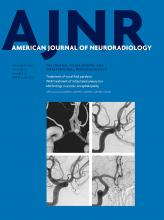We read with great interest the article by Karia et al1 on posterior reversible encephalopathy syndrome (PRES) evaluating the association between the presence of enhancement in PRES and various clinical factors in a large series of 176 patients with PRES. They found that the presence or pattern of enhancement in posterior reversible encephalopathy syndrome was not associated with any of the tested variables. However, they found a statistical association between MR imaging severity and outcomes, confirming that the grading of MR imaging severity may aid in determining the prognosis of patients with PRES. While we agree with the conclusions of the study, prediction of clinical outcomes in patients with PRES remains a challenging and controversial subject. The purpose of this correspondence is to discuss the current ideas regarding prognosis of PRES, which is still uncertain and open to discussion.
Although PRES is increasingly being recognized and successfully treated, the most important factors affecting its outcomes, such as permanent neurologic deficits, discharge status, and mortality, have not yet been well characterized.2 In our study including 70 patients with PRES, we found that there was no significant correlation between imaging patterns and clinical risk factors. Cytotoxic edema, intracranial hemorrhage, and abnormal enhancement did not show correlation with blood pressure, but correlated with higher edema scores. Furthermore, our recent study demonstrated that cytotoxic edema in PRES is frequently found in association with a larger area of vasogenic edema, which is probably related to regional decreased perfusion and vasculopathy. Presence of atypical neuroimaging appearances, such as cytotoxic edema, intracranial hemorrhage, and abnormal enhancement, are useful for prognosis in PRES because these findings may reflect intrinsic endothelial injury or BBB disruption.3 Based on the results of these studies, severity of brain edema in patients with PRES should be considered as one of the most significant risk factors in the clinical prognosis of this disorder. The specific etiology of PRES and biochemical parameters may represent the other important factors for its prognosis.4 Physicians should be aware of the various etiologies of PRES to allow for rapid diagnosis and treatment and to reduce morbidity of PRES. Prospective exploration is warranted to establish the imaging biomarker associated with unfavorable clinical outcomes in PRES.
The most widely used outcome measure of the degree of disability or dependence in patients with stroke is mRS score. Some investigators have used mRS score as a prognostic index during clinical follow-up of patients with acute illness at 1- and 3-month intervals after discharge. Clinical outcome was assessed as degree of disability or death by using mRS score. In this original research, the authors adopted a similar 5-category clinical outcome evaluation based on one of their prior studies of PRES and acute toxic leukoencephalopathy: grade 0, return to baseline clinical condition; grade 1, minimal residual cognitive deficit; grade 2, mild persistent neurologic deficit; grade 3, moderate persistent neurologic deficit; and grade 4, severe outcome, including no improvement, seizures, coma, or death. Glasgow Outcome Scale score on day 90 (67 days after onset of severe PRES) was also adopted as the primary evaluation criterion by some investigators, which may better reflect both mortality and morbidity, especially in critically ill patients or fatal cases.5
The diagnosis of PRES relies mainly on clinical symptoms and radiologic findings. We do agree with Fugate and Rabinstein's6 statement that “the diagnosis of PRES is not mainly radiological; the clinical context and the judgment of the clinician are crucial to making the correct diagnosis.” Clinical symptoms are the prerequisite in the diagnosis of PRES, and imaging findings are the essential condition. Neuroimaging is critical for prompt recognition of this entity and differentiation from other diseases. Though conventional MR imaging protocol is considered to be the criterion standard for the diagnosis or evaluation of PRES, DWI combined with ADC maps is sensitive for differentiating cytotoxic edema from vasogenic edema. Therefore, it is preferable to include DWI and ADC maps in work-up. In practice, ADC mapping is also helpful in some cases in which clinical diagnosis is unclear or difficult to determine.
In conclusion, the roles of imaging findings, clinical symptoms, and biochemical parameters in predicting prognosis of PRES warrant further investigation. A unified diagnostic algorithm should be sought to standardize the diagnosis of PRES and description of clinical outcomes, which will facilitate future research in exploring the role of neuroimaging for this disorder.
Footnotes
Disclosures: We declare no competing interests. Bo Gao reports a research grant from National Natural Science Foundation of China (No. 81471645). Meng Law reports grant support from Toshiba American Medical,* a consulting fee/honorarium from Bracco Diagnostics, and travel support from Guerbet. *Money paid to the institution.
Indicates open access to non-subscribers at www.ajnr.org
References
- © 2016 by American Journal of Neuroradiology












